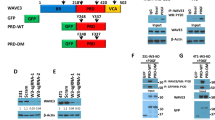Abstract
Hepatocyte growth factor (HGF) induces the breakdown of cell junction and the dispersion of colonies of epithelial cells, providing a model system for the investigation of the molecular mechanisms of one of the important aspects of tumorogenesis. We have previously reported that the SH2-domain-containing inositol 5′phosphatase (SHIP)-1 binds to c-Met, and potentiated HGF-mediated branching tubulogenesis. In this study, we describe the establishment of MDCK cell lines which express MycHis-tagged SHIP-1 at different levels. Expression of SHIP-1 in MDCK cells at a high level resulted in cell morphology characteristic of an epithelial-mesenchymal like transition; cells lost cortical actin, developed actin stress fibers and gained spontaneous motility without treatment of HGF. When the level of MycHis-tagged SHIP-expression was relatively low, transfectants partially lost cortical actin and phalloidin stained puncta appeared at cell–cell junctions even in the absence of HGF. The treatment of MAP kinase inhibitor, PD98059, did not influence SHIP-1 mediated alteration of adherens-junction of MDCK cells, while, phosphatidylinositol 3 (PI 3)- kinase inhibitor, LY294002, drastically reduced SHIP-1 mediated phenotype. Furthermore, expression of a mutant SHIP-1 lacking catalytic activity in MDCK cells did not alter the cortical actin distribution and HGF-mediated MAP and Akt kinase-phosphorylation, but suppressed HGF induced cell dispersion, suggesting that phosphatase activity is important for cytoskeleton rearrangement and cell dispersion.
This is a preview of subscription content, access via your institution
Access options
Subscribe to this journal
Receive 50 print issues and online access
$259.00 per year
only $5.18 per issue
Buy this article
- Purchase on Springer Link
- Instant access to full article PDF
Prices may be subject to local taxes which are calculated during checkout






Similar content being viewed by others
References
Boccaccio C, Andò M, Tamagnone L, Bardelli A, Michieli P, Battistini C, Comoglio PM . 1998 Nature (London) 391: 285–288
Bottaro DO, Rubin JS, Faletto DL, Chan AM, Kmiecik TE, Vande Woude GF, Aaronson SA . 1991 Science 251: 802–804
Erneux C, Govaerts C, Communi D, Pesesse X . 1998 Biochem. Biophys. Acta. 1436: 185–199
Giuriato S, Payrastre B, Drayer LA, Plantavid M, Woscholski R, Parker P, Erneux C, Chap H . 1997 J. Biol. Chem. 272: 26857–26863
Graziani A, Gramaglia D, Cantley LC, Comoglio PM . 1991 J. Biol. Chem. 266: 22087–22090
Hartwig JH, Kung S, Kovacsovics T, Janmey PA, Cantley LC, Stossel TP, Toker A . 1996 J. Biol. Chem. 271: 32986–32993
Helgason CD, Damen JE, Rosten P, Grewal R, Sorenson P, Chappel SM, Borowski A, Jirik F, Krystal G, Humphries RK . 1998 Genes Dev. 12: 1610–1620
Khoury H, Dankort DL, Sadekoya S, Naujpkas MA, Muller WJ, Park M . 2001 Oncogene 20: 788–799
Kong D, Suzuki A, Zou TT, Sakurada A, Kemp LW, Wakatsuki S, Yokoyama T, Yamakawa H, Furukawa T, Sato M, Ohuchi N, Sato S, Yin J, Wang S, Abraham JM, Souza RF, Smolinski KN, Meltzer SJ, Horii A . 1997 Nat. Genet. 17: 143–144
Leslie NR, Bennett D, Gray A, Pass I, Hoang-Xuan K, Downes CP . 2001 Biochem. J. 357: 427–435
Li J, Yen C, Liaw D, Podsypanina K, Bose S, Wang SI, Puc J, Miliaresis C, Rodgers L, McCombie R, Bigner SH, Giovanella BC, Ittmann M, Tycko B, Hibshoosh H, Wigler MH, Parsons R . 1997 Science 275: 1943–1947
Lioubin MN, Algate PA, Tsai S, Carlberg K, Aebersold A, Rohrschneider LR . 1996 Genes Dev. 10: 1084–1095
Ma AD, Metjian A, Bagrodia S, Taylor S, Abrams CS . 1998 Mol. Cell. Biol. 18: 4744–4751
Mancini A, Niedenthal R, Joos H, Koch A, Trouliaris S, Niemann H, Tamura T . 1997 Oncogene 15: 1565–1572
Naldini L, Weidner KM, Vigna E, Gaudino G, Bardelli A, Ponzetto C, Narsimhan RP, Hartmann G, Zarnegar R, Michalopoulos GK, Birchmeier W, Comoglio PM . 1991 EMBO J. 10: 2867–2878
Pelicci G, Giordano S, Zhen Z, Salcini AE, Lanfrancone L, Bardelli A, Panayotou G, Waterfield MD, Ponzetto A, Pelicci PG . 1995 Oncogene 10: 1631–1638
Phee H, Jacob A, Coggeschall KM . 2000 J. Biol. Chem. 275: 19090–19097
Ponzetto C, Bardelli A, Zhen Z, Maina F, dalla Zonca P, Giordano S, Graziani A, Panayotou G, Comoglio PM . 1994 Cell 77: 261–271
Potempa S, Ridley AJ . 1998 Mol. Biol. Cell. 9: 2185–2200
Rameh LE, Cantley LC . 1999 J. Biol. Chem. 274: 8347–8350
Rohrschneider LR, Fuller JF, Wolf I, Liu Y, Lucas DM . 2000 Genes Dev. 14: 505–520
Roucher D, Stauffer T, Chen W, Shen K, Gua S, York JD, Sheetz MO, Meyer T . 2000 Cell 100: 221–228
Royal I, Park M . 1996 J. Biol. Chem. 270: 27780–27787
Sakisaka T, Itoh T, Miura K, Takenawa T . 1997 Mol. Cell. Biol. 17: 3841–3849
Steck PA, Pershouse MA, Jasser SA, Yung WK, Lin H, Ligon AH, Langford LA, Baumgard ML, Hattier T, Davis T, Frye C, Hu R, Swedlund B, Teng DH, Tavtigian SV . 1997 Nat. Genet. 15: 356–362
Stefan M, Koch A, Mancini A, Mohr A, Weidner KM, Niemann H, Tamura T . 2001 J. Biol. Chem. 276: 3017–3023
Stoker M, Perryman M . 1985 J. Cell. Sci. 77: 209–223
Vasioukhin V, Bauer C, Yin M, Fuchs E . 2000 Cell 100: 209–219
Vollenweider P, Clodi M, Martin SS, Imamura T, Kavanaugh WM, Olefsky JM . 1999 Mol. Cell. Biol. 19: 1081–1091
Weidner KM, Di Cesare S, Sachs M, Brinkmann V, Behrens J, Birchmeier W . 1996 Nature (London) 384: 173–176
Acknowledgements
We thank Karsten Heidrich (MHH) for technical assistance, Larry Rohrschneider (Fred Hutchinson Cancer center, Seattle) for providing the SHIP cDNA, C Bruce Boschek for critically reading the manuscript. This research was supported by the Deutsche Forschungsgemeinschaft (Ta-111/8/-1), SFB566 (B2) and HiLF program to A Mancini.
Author information
Authors and Affiliations
Corresponding author
Rights and permissions
About this article
Cite this article
Mancini, A., Koch, A., Wilms, R. et al. The SH2-containing inositol 5-phosphatase (SHIP)-1 is implicated in the control of cell-cell junction and induces dissociation and dispersion of MDCK cells. Oncogene 21, 1477–1484 (2002). https://doi.org/10.1038/sj.onc.1205224
Received:
Revised:
Accepted:
Published:
Issue Date:
DOI: https://doi.org/10.1038/sj.onc.1205224



